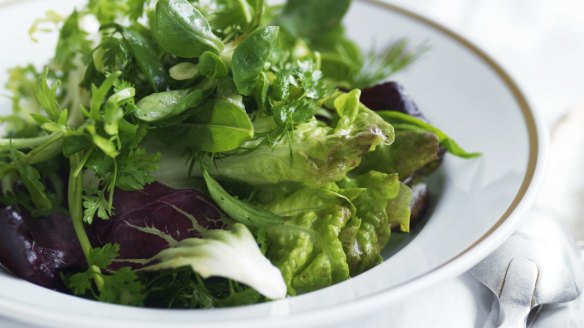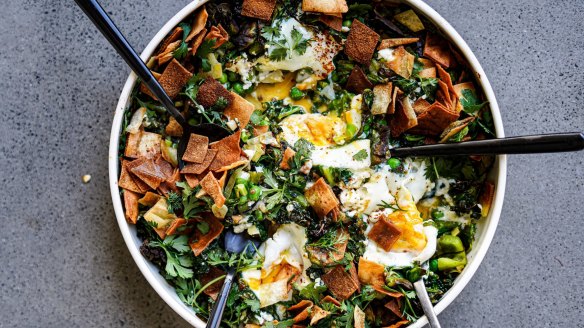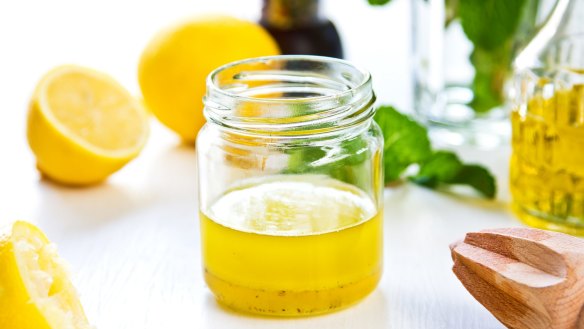Chefs share 12 tips to lift your salad game

At first blush, it seems like sorcery, the way salads at restaurants taste so much better than the ones we make at home. So we invited some of the country's greatest kitchen wizards to divulge their secrets. Here are 12 tips to magically lift your salad game.
Work from the ground up
I have always been told there is nothing like growing you own veg. During lockdown 2.0 we planted our very first lot of tomatoes…. OMG they are unlike any store-bought tomato; you really cannot compare. This was a "mind blown" moment!
Josh Pelham, RACV Cape Schanck Resort executive chef, Mornington Peninsula
Fresh is best
The ingredients themselves need to be smashingly fresh. Leaves must be separated carefully, then soaked in ice water for about 20 minutes, and you must, must, must have a salad spinner and dry them very well. Wet leaves lead to watery dressings.
Neil Perry, kitchen legend and Good Weekend contributor, Sydney
Get on the tear
The leaves in my mesclun (mixed leaves) are often but not limited to, green oakleaf, frisee, young (heart) cos, sorrel, parsley and mizuna. Don't ever cut the leaves, not even iceberg. Tear them if you really have to. It's a texture thing for me; you want that crunch and if you make the effort of having different leaves in your salad, you want to feel it when you eat them.
Rob Kabboord, Chancery Lane chef de cuisine, Melbourne
Vegetables matter
After a hot spell, leaves can often become bitter and that's a good time to start using vegetables as the base for a salad. Lately I've been using fresh, firm zucchini. Roughly chop some and shave others into thin slices, and toss them with mint leaves and roughly chopped toasted almonds, and dress with lemon juice and olive oil. If you want to make it more substantial, plate it on a schmear of hummus or top it with a poached egg.
Danielle Alvarez, author of Always Add Lemon and head chef at Fred's, Sydney
Use it all
Using carrot tops in a carrot salad not only adds a lovely light, sweet, herbal taste, it helps reduce waste. Chop the greens with fresh herbs such as parsley and coriander and toss them through the salad. Finely chop the parsley and coriander stalks, and add them too!
Alejandro Saravia, Farmer's Daughters and Pastuso, Melbourne
Get the balance right
A salad needs something crunchy and something salty. The salty ingredient doesn't have to be cheese. It could be preserved lemon peel cut into super-thin slices. And to add crunch, try roasted chickpeas, pepitas or nuts, or croutons.
Danielle Alvarez

Crunch time
I love using fried bread for a bit of texture. Some stays crunchy, and some soaks up all the delicious juices, acids and oils. A good tip is to shallow-fry a piece of pita bread 'til golden, drain on paper towel and season with sea salt flakes and sumac. Drizzle the fried pita with pomegranate molasses and place on top of your salad of choice, such as a fattoush. (Adding chopped avocado to fattoush is another hot tip.)
Tom Sarafian, guesting at Little Andorra, Carlton North
Oils ain't oils
Use a good quality local olive oil. Some people may not know that the freshness of olive oil is very important. Big-batch imported olive oil does not compare to local small-batch boutique producers. I always have a bottle of local Cape Schanck olive oil to finish such things as salads. Never, ever use "finishing" oil to pan-fry. It simply burns.
Josh Pelham
The acid test
Have at least one good quality vinegar in the pantry. Each vinegar has its place and each has a different acidity and sweetness level. Sweet aged balsamic is best with such vegetables as tomatoes, red onions and red peppers; chardonnay vinegar with crisp, cold iceberg lettuce; and sherry vinegar is bold and robust, great with legumes and pulses.
Josh Pelham

Dressing up
It's as simple as 1, 2, 3, 4 (the start of every Ramones song). 1. Take one part good vinegar. 2. Put it in an empty jar. 3. Add three parts good oil (Frantoia from Mount Zero is great). 4. Put the lid on and shake.
Rob Kabboord
Not drowning, coating
Place about 3 tablespoons of dressing in a large stainless bowl, mix the leaves gently through by hand, and season with salt and pepper. If they're a little dry, add more dressing a tablespoon at a time. The leaves must be coated, not drowned. Place in a beautiful bowl and serve.
Neil Perry
A matter of taste
It's crucial to keep tasting a dish as you make it, and to pause for a second to taste all different components together before you serve it. Try to analyse the seasoning, the level of acidity, the amount of dressing. Keep tasting and it will start to sink in how to perfectly balance all the flavours.
Danielle Alvarez
The best recipes from Australia's leading chefs straight to your inbox.
Sign up- More:
- How to
